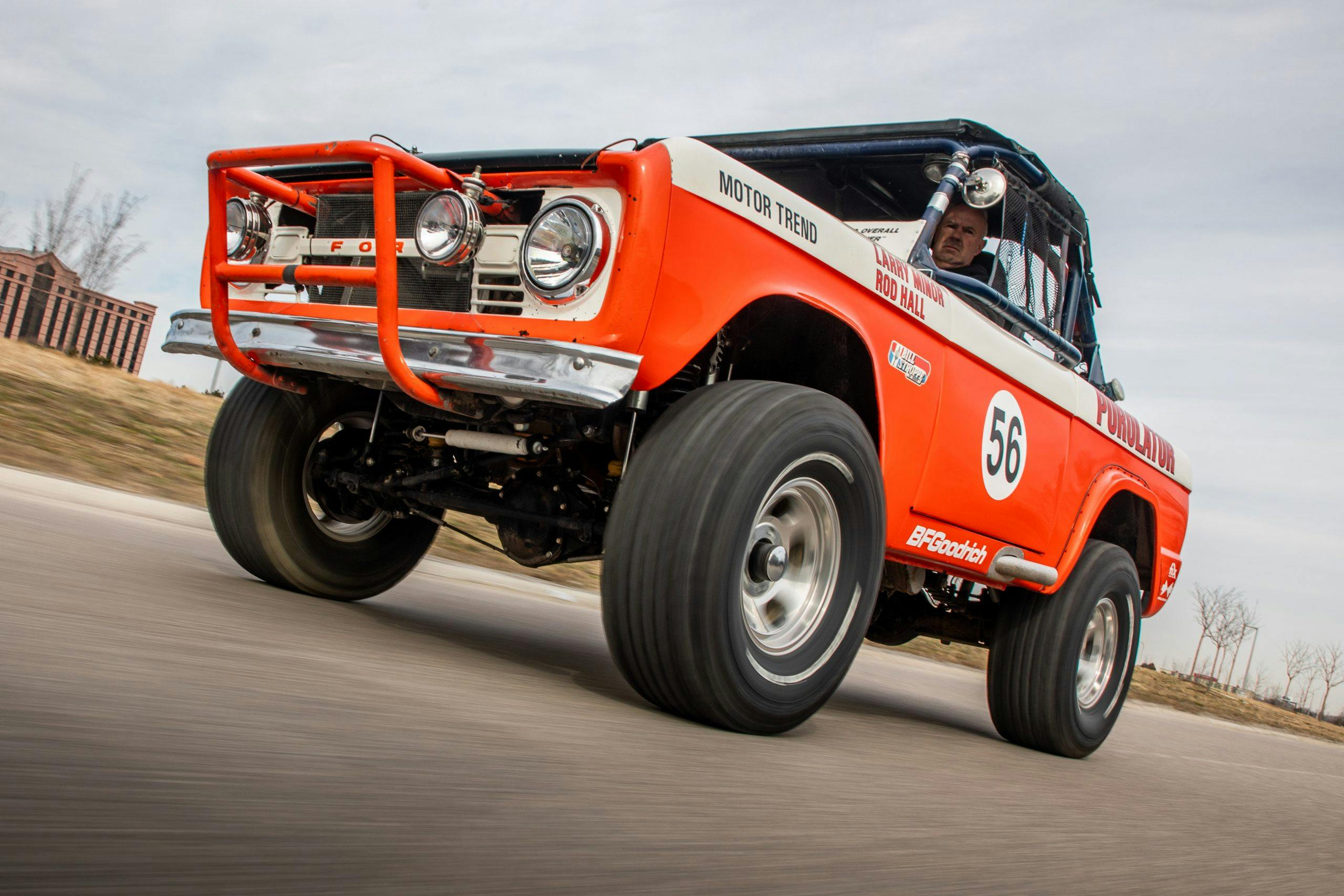A brief history of the Ford Bronco generations
First generation: 1966–1977
Jeep and International Harvester were the big players in the early 1960s SUV market, with the Toyota FJ40 and Nissan Patrol selling in much lower numbers. Because all of those competitors offered utilitarian off-roaders that rode on short wheelbases, Ford saw the potential for a vehicle that could go toe-to-toe on the trail but still offer an improved ride.
In a press release months prior to its launch, Ford Vice President Donald N. Frey said, “We believe the Bronco will offer customers new standards in this type of vehicle including ruggedness, maneuverability, and ‘go anywhere’ roadability.”
Differentiating itself from the IH Scout, Jeep CJs, and the rest of the off-road market, the Bronco was the first production 4×4 to offer a coil spring front suspension. Coil springs allow for greater articulation off-road and offer a wider range of options for tuning the suspension geometry than leaf springs. It wasn’t until 1997 that the Wrangler moved to coil springs. The result was a competent trail vehicle with decent road manners.
At its launch in late 1965, a six-cylinder was the only engine available, but an optional 289 V-8 was added in April of 1966. A 302 followed less than two years later. The early Bronco was available as a four-seat wagon with full top, a half-cab pickup, and as a roadster with no top at all. By 1973, only the wagon remained.
In 1971, Bill Stroppe and Associates in Long Beach, California, prepared a “Baja Bronco” package that included a roll bar, wider wheels, trailer hitch, dual shock absorbers front and rear, and modified wheel openings with flares. They would all be painted red, white, and blue, with a flat black hood. Ford installed a swing-out spare tire carrier, locking hubs, a heavy-duty suspension, and a 10.3-gallon auxiliary fuel tank.
Stroppe, whose factory-backed Broncos had won the Baja 1000 in 1969 and Baja 500 in 1970, boasted, “The Baja Bronco should be as good a combination of off-road vehicle and on-highway car as is possible.”

Second generation: 1978–1979
Moving its target a bit, the second-generation Bronco grew in every dimension to take on the popular full-size two-door 4×4 category where the Chevy Blazer/GMC Jimmy, Dodge Ramcharger/Plymouth Trailduster, and Jeep Cherokee were duking it out.
The move to full-size meant that Bronco now shared much of its parts—basically everything from the B-pillar forward—with the F-Series. It also meant an end of the full removable top. While the fiberglass top covering the cargo area and rear seats could still be unbolted and removed, there was a permanent roof over the front two passengers. Chevrolet and GMC had made a similar change for its 1976 models and Chrysler eliminated the Ramcharger’s removable roof totally in 1981.
Although originally planned for 1974 and delayed because of the oil crisis, the second-gen Bronco was an immediate sales success, and retail deliveries of the 1978 Bronco totaled 82,343, an all-time high for the Bronco. Up to that point, anyway.

Third generation: 1980–1986
The short-lived second-generation Bronco was updated along with the rest of the F-Series lineup for 1980. A major change was a new “Twin Traction Beam” (TTB) front axle from Dana that would be the first independent front suspension available on a full-size 4×4.
When it’s not articulated, a TTB axle looks quite like a solid axle, but a universal joint and intermediate shaft on the passenger side axle allow each side to move independently on two pivot points. The benefit of reduced sprung weight of a single traction beam compared to an entire solid axle allows the wheels to react more quickly to dips and bumps. The downside is that despite having a relatively long beam, there’s significant camber change as the suspension cycles as opposed to a control arm suspension.
Ford’s venerable 300-cubic-inch inline-six was the base engine, 302 and 351 V-8s were optional. In 1985, a multiport fuel injection version of the 302 was available, increasing output to 190 horsepower, sixty horsepower more than the carbureted 302, and just 20 horsepower down from the carbureted 351. For 1986, the 302 came standard with fuel injection, although the power was now a claimed 185 horses.

Fourth generation: 1987–1991
New front sheet metal and a new interior design somewhat disguised the fact that fourth-generation Bronco was really what we’d call a mid-cycle enhancement today. All future full-size Bronco generations would be based on the same basic platform that debuted in 1980.
The carbureted 351 continued to be the top powerplant, but now the base 300-cu-in inline-six was also fuel injected. The 351 followed suit in 1988, with an intake manifold that mimicked the asymmetrical, long-runner design found on the 5.0-liter.

Fifth generation: 1992-1996
Powertrain options carried over for the final generation of the Bronco, built on the ninth-generation F-series platform. The gently sloping leading edge of the hood, along with a larger grille that rounded the interior edge of the otherwise square headlights, made the front end look more modern and aerodynamic while keeping an overall assertive and powerful presence. It did a great job of modernizing the basic shape of the Bronco that had been relatively unchanged since 1980.
Annual sales for the final five years of full-size Bronco production averaged 32,000, yet when Ford developed a new F-150 for 1997, it found no place in the lineup for a full-size two-door SUV. Instead, Ford gave us the four-door-only Expedition to battle with Tahoe, Yukon, and eventually the Suburban.
Chevrolet’s two-door Tahoe and GMC Yukon left the market in 1999, and almost all of the compact two-door SUVs followed suit shortly thereafter. That has left the Jeep Wrangler as the only two-door SUV on the market. When the 2021 Bronco is finally unveiled in both two- and four-door guise, it’s going to mark the first time Jeep has had any real competition in decades. We’re excited for both Ford’s long-awaited Bronco, and perhaps Jeep’s answer.










